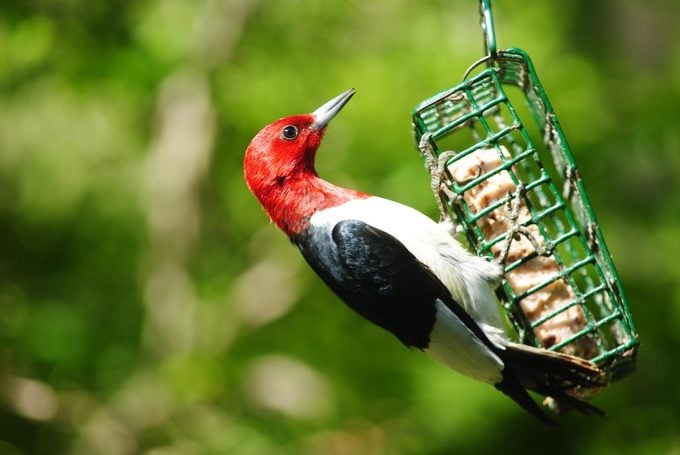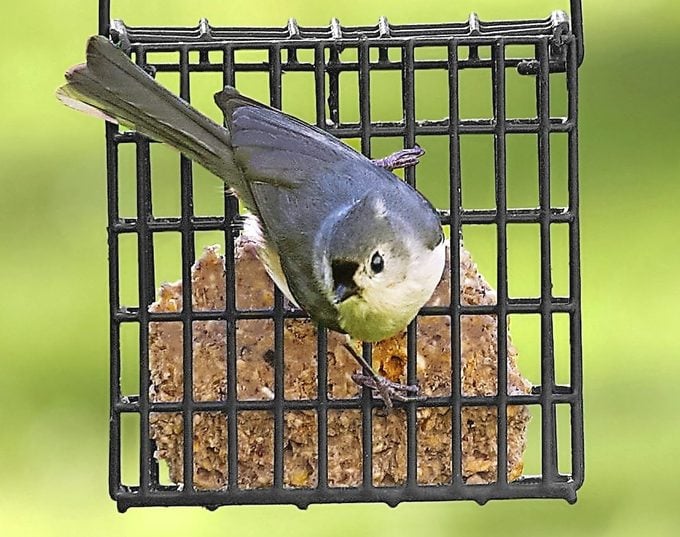The Essential Guide to Rendering Suet for Birds
Updated: Nov. 30, 2023
Whip up DIY suet cakes yourself! It's easy (and cheap!) Learn the do's and don'ts of rendering beef suet for birds.

Stroll through any bird store and you’ll find prepackaged suet squares readily available in many varieties, from pure suet to those that include seeds, nuts and berries. While those are fine options, it’s fun and inexpensive to make your own. Learn the do’s and don’ts of rendering suet for birds.
On This Page
Rendering Beef Suet for Birds
Real suet, in its traditional form, is raw beef fat. Raw suet needs to be rendered. Available at most butcher shops, the good stuff is super popular among nuthatches, chickadees and all woodpeckers, especially during the cold months. In fact, suet is one of the best foods for woodpeckers.
First, chop it into small pieces. (If you purchase it from a butcher, he or she may do this for you.) Next, heat the chopped fat on low until it’s completely melted. To remove potential contaminants, strain the liquid fat twice through a layer of cheesecloth. This also ensures that your suet cakes stick together and don’t crumble.
Psst—Check out the best suet feeders for winter birds.
How to Make DIY Suet Cakes

You can serve rendered suet plain or put a little love into it and experiment with various bird-safe ingredients. Mix in unsalted nuts and seeds, fruits and berries, peanut butter and cornmeal until the consistency is a bit stiff. Some people even mix in dried mealworms and other insects to entice bluebirds! Once the mixture has cooled a bit, press into molds (try cat food or tuna cans, or form into your favorite shape) and refrigerate.
Making your own suet involves a bit of trial and error. Depending on the ingredients you choose to mix in, you may need to experiment with the ratio of ingredients to avoid crumbly cakes.
“What’s your favorite suet recipe?” asks Birds & Blooms reader Diane Mlekush of McHenry, Illinois.
We actually haven’t settled on a favorite recipe, because we’re always experimenting with new ideas. But when we make suet, we always begin with equal parts lard and peanut butter, melting and mixing them over low heat. We add a variety of ingredients to this gooey mess: peanuts, raisins, rolled oats and cornmeal, to name just a few. Then we chill the mixture for a day before cutting it into blocks or cubes. When you offer birds homemade suet, check it regularly to be sure it isn’t moldy or rancid.
Switch up your bird feeding habits to see new species.
Safe Ingredients for Suet
- Black-oil sunflower seeds
- Unsalted nuts
- Dried fruit
- Peanut butter
- Cornmeal or flour
- Other birdseed
- Rolled oats
Check out 8 common questions about suet for birds.
Unsafe Ingredients for Suet
While rendering suet to attract birds is incredibly rewarding, there are a few things to know before you jump in headfirst. Always avoid bacon grease, bread and table scraps. Ingredients such as corn and peanuts sometimes foster dangerous bacteria. If you use these, it’s important to keep the mixture refrigerated until you’re ready to use it in your feeders.
- Bread
- Sugar
- Leftovers
- Meat
- Bacon fat
- Salted nuts
Discover 9 foods you should never feed to birds.
Make Suet Cakes With Lard, Not Bacon Grease
Lard is a safe alternative to rendered beef fat. In fact, a combination of lard and peanut butter makes a nice base for any bird-friendly recipe. But bacon drippings are not recommended because the chemical preservatives in commercial bacon become more concentrated when cooked. This doesn’t pose a health threat to humans but can be harmful to birds.
Next, see our list of the foods you should feed birds in winter.





















